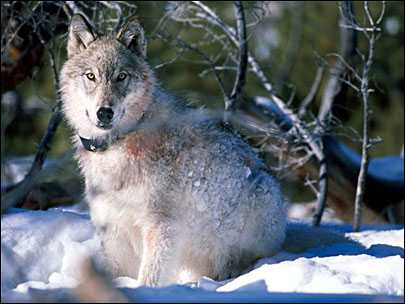
Story Published: May 4, 2011
BILLINGS, Mont. (AP) – The Obama administration on Wednesday moved to lift Endangered Species Act protections for 5,500 gray wolves in the Northern Rockies and Great Lakes, drawing the line on the predators’ rapid expansion over the last two decades.
Public hunts for hundreds of wolves already are planned this fall in Idaho and Montana.
Conservationists have hailed the animal’s recovery from near extinction last century as a landmark achievement – one that should be extended to the Pacific Northwest and New England.
But the federal wolf program has stirred a backlash from agriculture and sporting groups angry over wolf attacks on livestock and big game herds. Interior Department officials said Wednesday that the most suitable wolf habitat already was occupied. No further introductions of the species are planned.
Western lawmakers attached a rider to the federal budget bill mandating the move to lift protections for 1,300 wolves in the Northern Rockies. The rider, which barred any courtroom challenges, marked the first time Congress has removed an animal listed under the endangered act. Protections for the Rocky Mountain wolves are to be lifted effective with a Thursday notice in the Federal Register.
“To be sure, not everyone will be satisfied with today’s announcement,” said Interior Secretary Ken Salazar. “Wolves have long been a highly charged issue. These delistings are possible because the species is recovered in these regions. That is a remarkable milestone for an iconic American species.”
About 4,200 wolves listed as threatened in the western Great Lakes also are slated to lose protections. That could happen by the end of this year, following the review of public comments received on the proposal over the next two months.
The Great Lakes proposal also includes portions of North and South Dakota, Iowa, Illinois, Indiana and Ohio, although government biologist Laura Ragan no wolves permanently reside in those states.
A pending petition before the Interior Department seeks to extend the government’s wolf recovery plan nationwide. But Noah Greenwald with the Center for Biological Diversity, the sponsor of the petition, said Wednesday’s announcement made clear that the government has no such intentions.
“In our view wolf recovery is not done,” Greenwald said. “We’re disappointed with seeing the Fish and Wildlife Service attempt to get out from under it.”
Fish and Wildlife officials said they plan to review the gray wolf’s status in New England and the Pacific Northwest but did not foresee another reintroduction effort.
Idaho officials have said they want to reduce their state’s wolf population to about 500 animals, versus current estimates of more than 700.
Rancher Royce Schwenkfelder, whose family arrived in the western Idaho town of Cambridge in the 1880s, said he feels more comfortable with wolves under state jurisdiction. But he was doubtful that wolves could be reduced to levels that will eliminate attacks on cattle that he runs on Indian Mountain. “The feds have filled us up with more wolves than we can handle,” Schwenkfelder said.
Montana wildlife officials this week proposed a public hunt for up to 220 wolves this fall, out of a population estimated to number at least 566 animals. The state’s Democratic U.S. Senators, Max Baucus and Jon Tester, said Wednesday that turning over control of wolves to state wildlife agencies was the right thing to do.
“State biologists need to manage them like any other recovered species,” said Tester, who worked with Idaho Republican Rep. Mike Simpson to get the rider in the budget bill.
No hunts are planned immediately for small populations of wolves in Oregon, Washington and Utah.
In addition to the hunts, officials say wolves that attack livestock will continue to be removed by wildlife agents. More than 1,500 wolves have been killed for livestock attacks since the animals were reintroduced to the Northern Rockies from Canada in the 1990s.
Idaho state Rep. Judy Boyle, who sponsored a bill giving Gov. C.L. “Butch” Otter the authority to declare a wolf disaster emergency, said hunting alone won’t be enough to reduce the number of wolves to levels in which they aren’t a threat to livestock or wildlife.
Under state management, Idaho will continue to ask federal wildlife agents to take out problem packs, including in north-central Idaho’s Lolo area, where the state wants to kill dozens of wolves to help restore elk herds that have been hurt by predators and poor habitat, she said.
Michigan, Minnesota and Wisconsin have plans meant to keep the populations at healthy levels while allowing government agents to kill animals that can’t be driven away. None would allow hunting or trapping for at least five years, although the states could revise those plans.
Wednesday’s announcement leaves the fate of about 340 wolves in Wyoming unresolved. Wyoming was carved out of attempts to restore state control over wolves because of a state law that would allow the animals to be shot on sight in most of the state.
Salazar and his staff have been negotiating for months over the issue with Wyoming Gov. Matt Mead.
Mead said Wednesday that he was hoping for an agreement with the administration to get a bill through Congress lifting protections in his state. The governor suggested legislation that was the only way to prevent lawsuits from environmentalists that could otherwise derail the effort.
Associated Press writer John Miller in Boise, Idaho, contributed to this story.
www.komonews.com, May 4, 2011

Leave a Reply